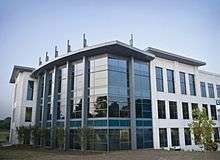Charlotte School of Law
 | |
| Type | For-Profit Law School |
|---|---|
| Established |
2006 ABA Provisional Accreditation: 2008 Full ABA Accreditation: 2011 ABA Probation: 11/14/2016 |
| Dean | Jay Conison[1] |
Academic staff | 100+ |
| Students | 1200+ |
| Location | Charlotte, North Carolina, USA |
| Campus | Urban |
| Website | http://www.charlottelaw.edu |
Charlotte School of Law (Charlotte Law), located in Charlotte, North Carolina, is an independent for-profit college that was established in 2006, provisionally accredited in 2008 and fully accredited by the ABA in 2011. Charlotte Law is owned by the InfiLaw System which also owns Florida Coastal School of Law and Arizona Summit Law School.
Campus
Charlotte School of Law is located at 201 South College Street in Uptown Charlotte. The building contains classrooms, the school's law library, an appellate courtroom, offices, and the school bookstore.
Academics
The school offers a 3+3 partnership with Johnson C. Smith University. Students complete 3 years at Johnson C. Smith and then enroll in law school, completing both a bachelor's degree and JD in 6 years. [2]
Initiatives
Charlotte School of Law students can participate in the Moot Court Program. Members of the Charlotte School of Law’s Moot Court Board are selected through an intra-school competition organized and run by students and judged by members of the legal community. The intra-school competition is named after Susie Marshall Sharpe, North Carolina’s first female state Supreme Court Chief Justice.
The Charlotte Law Review, a student-edited scholarly legal journal, publishes two issues yearly, a Spring and a Fall Journal, with plans of publishing its first Symposium Edition. The Law Review accepts manuscripts for consideration from sources both within and outside the Charlotte Law School community.
Student organizations
- Student Bar Association - Executive
- Student Bar Association - Senate
- Phi Alpha Delta
- Women in Law
- CharlotteLaw Cares
- CharlotteLaw Diversity Alliance
- LGBT Legal Society
- Federalist Society
- Part-Time Student Association
- International Law Society
- American Constitution Society
- Environmental Legal Society
- Moot Court
- Law Review
- CharlotteLaw Republican Society
- CharlotteLaw Global Poker & Strategic
- CharlotteLaw Sports & Entertainment
- Black Law Student Association
- Real Estate Law Society
- Order of the Crown (Scholastic Leadership Society)
- Parents Attending Law School
Employment
According to Charlotte's official 2013 ABA-required disclosures, 30.3% of the Class of 2013 obtained full-time, long-term, JD-required employment nine months after graduation.[3] Charlotte's Law School Transparency under-employment score is 37.7%, indicating the percentage of the Class of 2013 unemployed, pursuing an additional degree, or working in a non-professional, short-term, or part-time job nine months after graduation.[4]
Costs
The total cost of attendance (indicating the cost of tuition, fees, and living expenses) at Charlotte for the 2013-2014 academic year is $41,000.[6] The Law School Transparency estimated debt-financed cost of attendance for three years is $194,000.
Probation
Effective November 14, 2016, Charlotte School of Law was placed on probation by the ABA.
Charlotte School of Law failed to adhere to the following ABA standards:
Standard 301
(a) A law school shall maintain an educational program that prepares its students for admission to the bar, and effective and responsible participation in the legal profession.
Standard 501
(a) A law school shall maintain sound admission policies and practices, consistent with the objectives of its educational program and the resources available for implementing those objectives.
(b) A law school shall not admit applicants who do not appear capable of satisfactorily completing its educational program and being admitted to the bar.
The ABA required Charlotte School of Law to
- supply its admission methodology,
- create a plan to come into compliance with accreditation standards
- post on its website and notify all of its students it is on probation, and
- notify all students after grades are submitted at the end of each semester the North Carolina and South Carolina bar passage rates of each grading quartile and which quartile the student falls into.[7]
References
- ↑ Jay Conison (’81) Named Dean of Charlotte School of Law, University of Minnesota Law School, February 21, 2013, accessed March 18, 2013.
- ↑ http://www.jcsu.edu/academics/jcsu-undergraduate-pre-law-program/jcsu-and-the-charlotte-school-of-law
- ↑ "Employment Statistics".
- ↑ "Charlotte School of Law Profile".
- ↑ "Employment Summary for 2013 Graduates" (PDF).
- ↑ "Tuition and Expenses".
- ↑ "ABA Probation Letter" (PDF).
External links
Coordinates: 35°13′25″N 80°52′17″W / 35.2236°N 80.8715°W